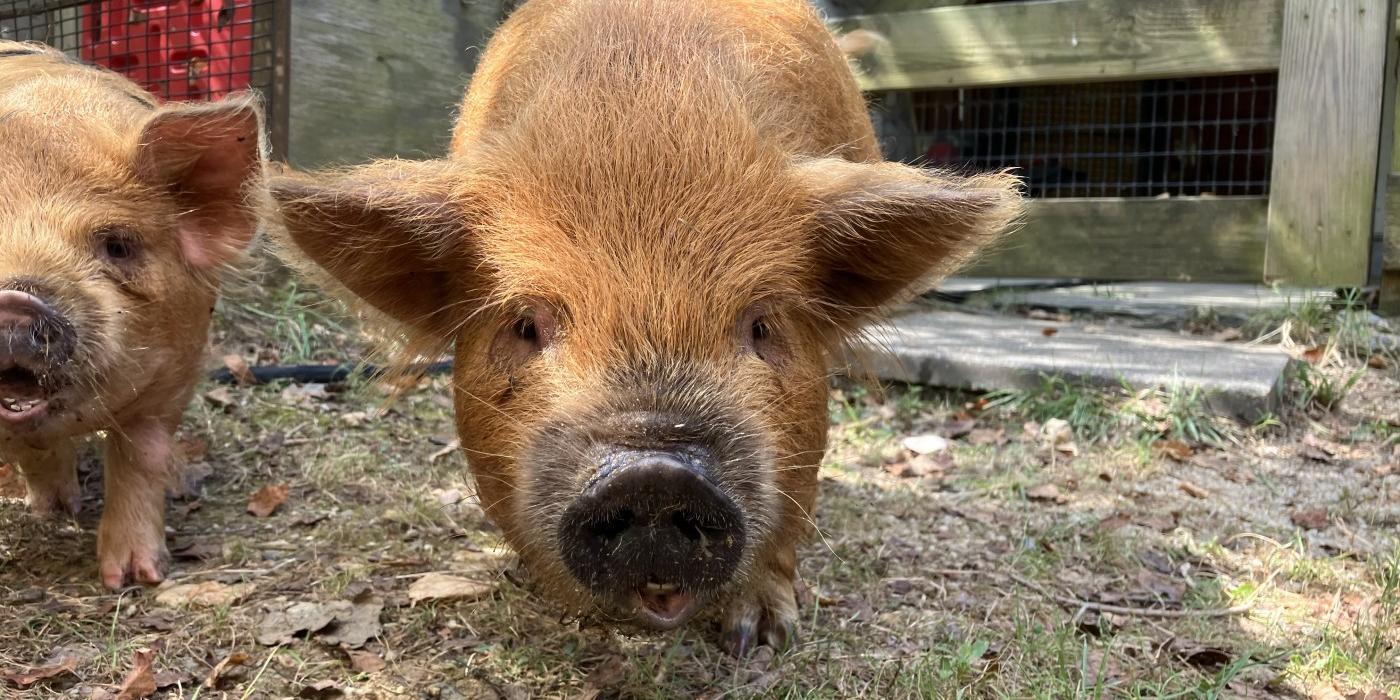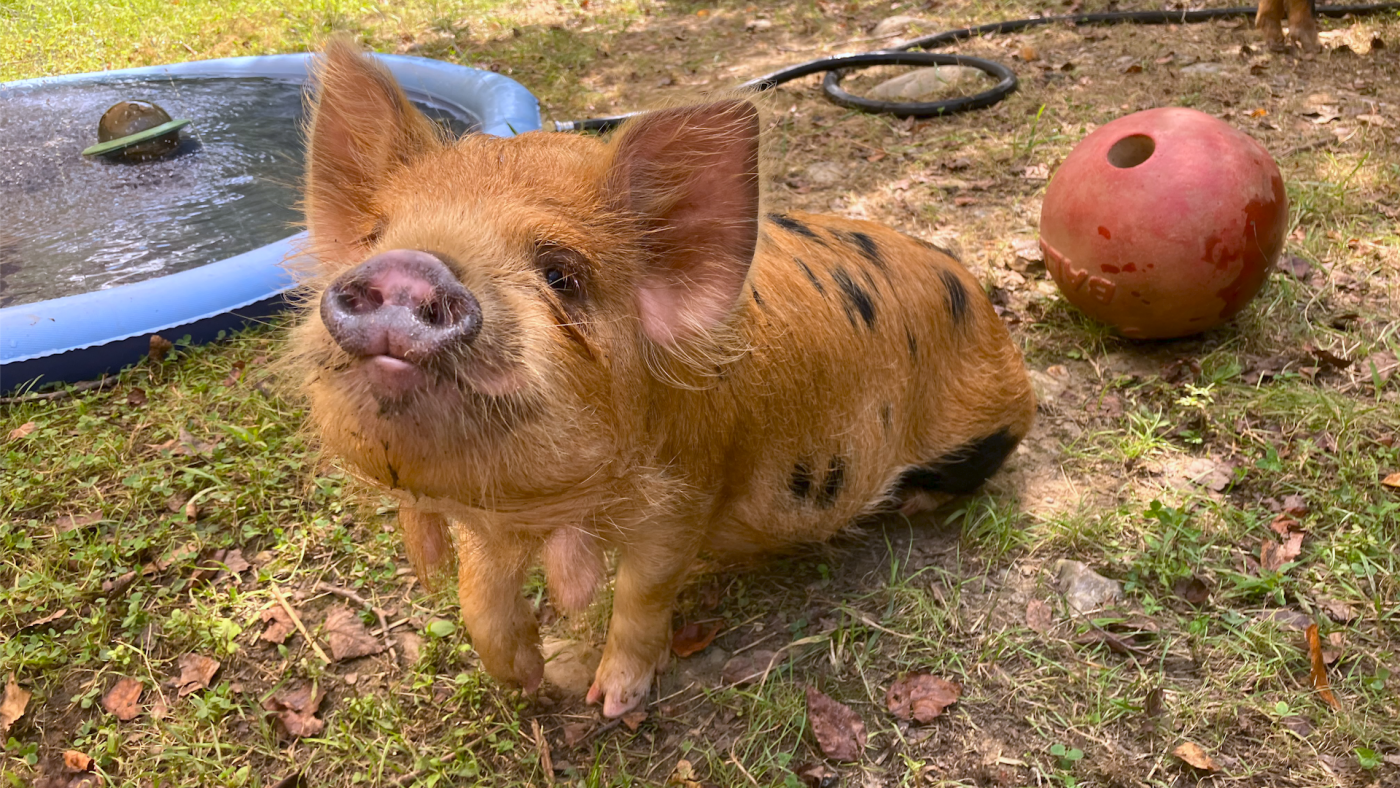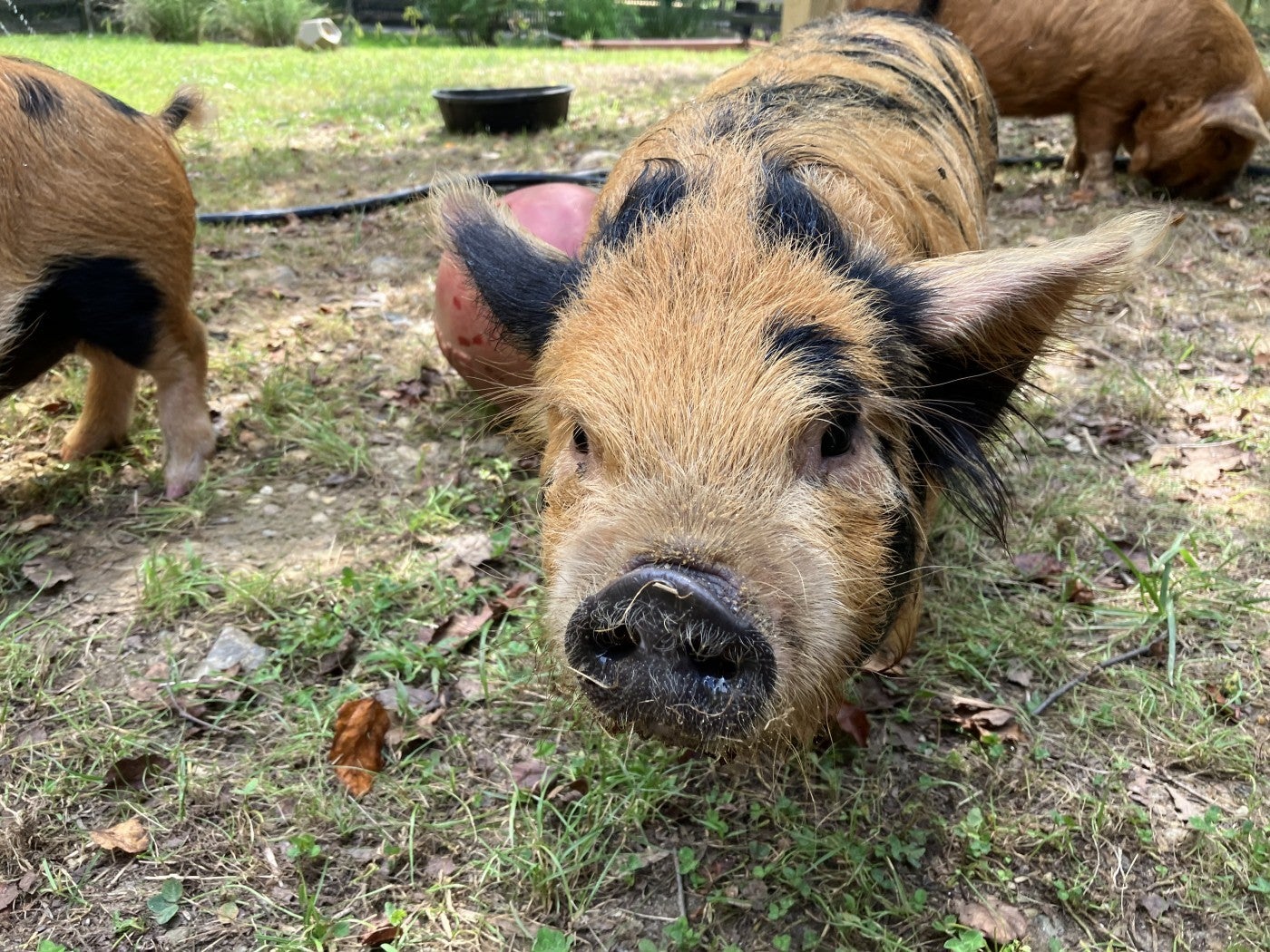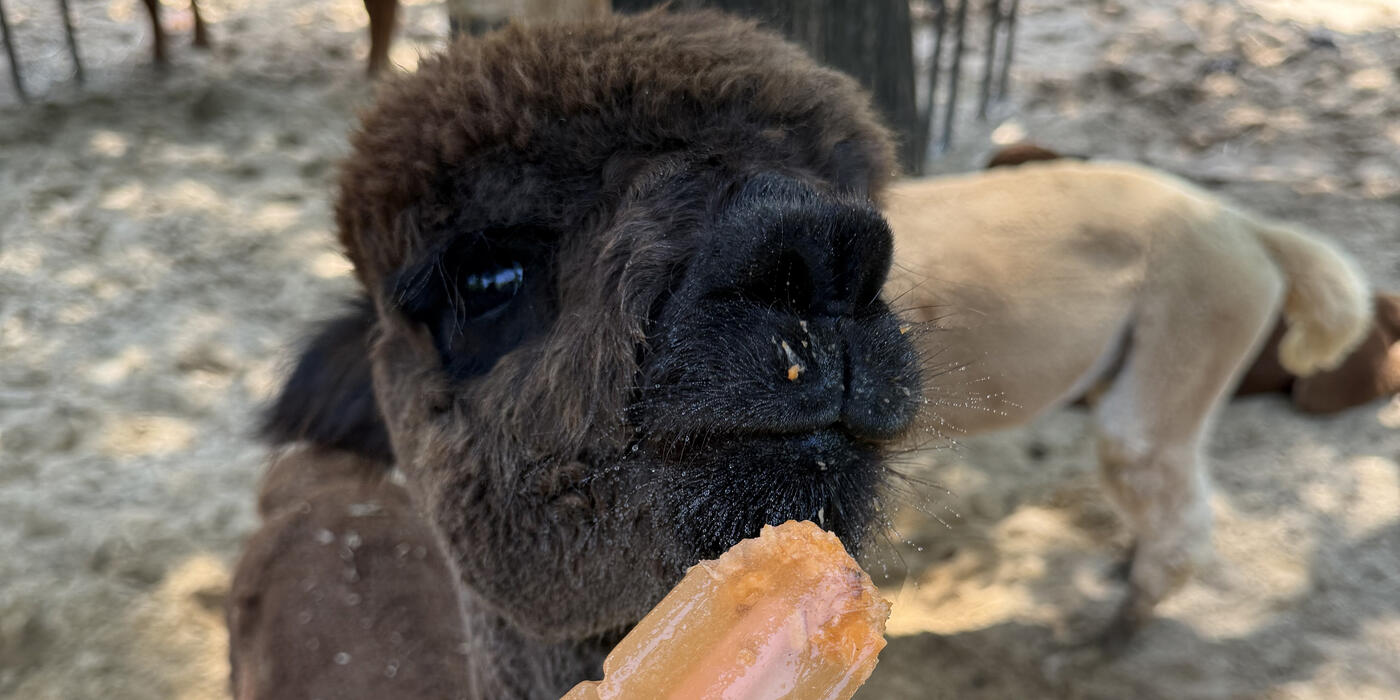New at the Zoo: Kunekune Pigs!

The Kids’ Farm just got even cuter! In late August, three young kunekune (pronounced KOO-nee KOO-nee) pigs joined the Farm and are already charming visitors. Learn about this unique breed in our latest New at the Zoo feature, featuring animal keeper Nikki Maticic.
Who are our kunekunes pigs?
We have three wonderful male kunekune pigs: Otis, Winston and Norman. Otis and Winston are brothers, and Norman is a bit younger, from a separate litter. All three are around four to five months old. We worked with Red Roof kunekune breeder in Southern Virginia to bring the boys to the Zoo. We are immensely grateful to their team for all their knowledge in preparing us to receive the kunekune pigs!
Our kunekune pigs arrived at the Zoo in late July and entered quarantine. All animals that come to the Zoo must undergo a quarantine period when they first arrive to the Zoo. This allows the animal to settle in and ensures they are healthy prior to us bringing them to their exhibit area around other collection animals. In late August, the boys moved on exhibit to the Kids’ Farm.
What makes kunekune pigs unique?
Kunekune pigs exhibit greater grazing behavior than other pig species and can derive a large share of their nutrition from pasture grasses and forbs. Compared to other pigs, kunekunes have a unique physical feature – small, fleshy wattles on either side of their faces: the Maori word for this is ‘piri–piri.’ Not all kunekunes have these wattles, but most of them do!
What is a myth about pigs you’d like to debunk?
One myth about pigs in general is that they are dirty animals. Pigs are actually known for being very clean! They tend to keep their sleeping areas very tidy, with separate areas of their enclosure being used for urination and defecation.
What three words would you use to describe the boys' personalities, and why do they suit them?
Curious, sweet and easy-going! The boys were very curious about their new exhibit at the Kids’ Farm and enjoyed exploring their yard. They are all very sweet, and often seek out attention for pets and belly rubs! They can be a little vocal at feeding time, and love greeting keepers with oinks and squeaks when they are working alongside their exhibit areas. They are also very easy-going and have been adjusting well to their new routine of living at the Kids’ Farm.
What has been your favorite moment working with the kunekunes thus far?
Kunekune pigs are a first for me, so I am very excited to be working with them! I have loved watching them settle in and seeing how quickly they pick up on their training. It has been so great having so many staff members and guests come to visit them at the Farm – the boys have loved getting so much attention!

Norman is the youngest of the pigs and is not related to Winston and Otis.
What do kunekunes eat? Do they have a favorite food(s)?
As natural grazers, kunekune pigs tend to eat a lot of grass, but also eat hay and grains. Our kunekunes have access to grass in their exhibit yard each day and we give them browse (leafy branches) twice a week. The boys receive a pelleted pig grain twice a day and a variety of vegetable and leafy green options, which we also use for enrichment and/or training. Right now, the pigs love their grain and grass the most, but we are offering them a variety of produce, such as carrots, zucchini, kale and broccoli, to learn what some of their favorites might be!
What are some of the boys' favorite enrichment items? How do they interact with them?
Since they’re still so new to the Farm, the boys have not interacted with too many enrichment items yet. They do enjoy exploring their yard and going into their wallow! Kunekune pigs love water, so we offer them a splash pad to be able to cool off, which has been a big hit! Brushing, belly rubs and rubbing on scratch pads have also been very popular with the boys. They enjoy interacting with their keepers, seeking them out for scratches and playing with their shoelaces!
What natural behaviors do they encourage them to use?
Even though they are grazers, we can use puzzle feeders to encourage them to explore other areas of their yard. We can also give them different substrate piles (such as sand or mulch) for them to lay in and nose through, in addition to enrichment opportunities such as small pools and sprinklers!
What husbandry training behaviors are they learning?
Currently, the boys are working on a few different behaviors. They are picking up on things fairly quickly and are already target trained! We are helping them get comfortable with having their hooves and mouths touched for hoof and tusk trims in the future and presenting their bellies for veterinary exams! We are also working on station training with them. During their morning and afternoon feeding sessions, we have each pig eat their grain in a certain area of their stall on a colored tray, so that each pig has a designated spot in the stall for food. We hope to use this behavior when weighing them in their stall, so that we can easily have one pig come over at a time to get weighed!
We also are working with them on a recall behavior. When the boys were in quarantine, the keepers worked on associating a cow bell with their grain. We have been continuing to do the same, both in their holding stall and in their exhibit yard! Each morning and afternoon, we ring the bell and let the pigs out of their current area. When the pigs arrive at the location we’d like them to be in, we give the bell a final ring and they are given the jackpot: their grain! Even though the boys are still getting used to their new area at the Farm, they have picked up on this recall behavior quickly and are doing great at continuing to learn to follow the recall!

Otis' brother Winston loves to play with his keeper's shoelaces!
What are their rewards for participating in husbandry training?
With their recall and station training, we use their grain as a reward. They love eating it so it’s a high value reinforcement item for them! For their other training, we use produce, such as broccoli or chopped bits of leafy greens!
As domesticated pigs, kunekunes aren't found in the wild. Why is it important for us to tell their story?
I think it’s important to tell their story because it shows what having passion about saving a species can do! While their origins date back to the Maori people of New Zealand and other areas of the Pacific, the kunekune pig breed almost went extinct in the 1970’s. A small group of kunekunes were rounded up to be bred. A few decades later, thanks to the work of passionate conservationists, there is now a stable population of the breed. While kunekunes are still considered rare, they are now found as domestic pets across areas of Europe, the U.S., and other parts of the world!
What do you hope visitors take away from meeting the boys?
I hope that visitors take away that the boys are ‘more than just a pig.’ They have a lot of personality and intelligence that makes them wonderful as individuals. We also hope that while people love to see how adorable these small, young boys are, they realize that they will get much, much bigger – up to 300 pounds to be exact! They are a medium sized pig breed and are not mini or micro pigs.
Got any tips for spotting them on exhibit? Do they have a favorite hangout spot?
The boys enjoy sleeping in a bit, so they have been staying in their holding barn/yard (the small red barn directly next to the large Kids’ Farm Barn) until later in the morning (around 9-10 a.m.). They travel over to their exhibit yard for most of the day and usually return to their holding barn/yard around 2-3 p.m. Eventually, when they are larger, they will be able to remain on exhibit for longer periods of time!
When they are out on exhibit, they love hanging out in their wallow and in their splash pad. When they aren’t exploring their grassy areas, they enjoy coming up to the fence for pets from visitors. They will often fall asleep basking in the sun along the fence! If you don’t see them on exhibit, be sure to listen for their squeaks and grunts in their holding yard or look through the windows to see their adorable ‘pig pile’ that the boys make when they sleep all together!
I want to help kunekunes! What steps can I take to protect them?
I would say if you are interested in learning more about kunekunes or even owning your own pigs, be sure to do your research! There are many different breeds of pig, and people have them for different reasons. Kunekunes are a rare breed in the sense that they typically don’t root, so they are much less destructive to their pasture (and fencing!) than many other pig breeds. They can be used as a meat breed and they do not require as much food as other breeds since they graze. Their docile personalities around people of all ages and other animals make them a very useful pig breed to have around!
Related Species:
